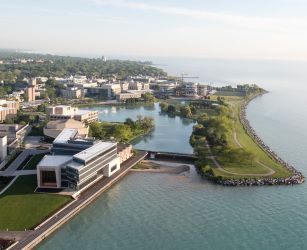Energy & Emissions
Northwestern’s GHG emissions are categorized and aligned to the international Greenhouse Gas Protocol as follows:
- Scope 1: These are the direct emissions occurring as a result of Northwestern’s use of fossil fuels, such as burning natural gas to heat campus facilities or using diesel or gasoline in campus owned and operated fleet vehicles.
- Scope 2: These are the indirect emissions from Northwestern’s use of electricity. They are considered indirect because electricity is consumed on campus, but the emissions occur from the burning of fossil fuels or other energy sources to produce electricity at a power plant.
- Scope 3: These are the indirect, “supply chain” emissions from other sources in Northwestern’s campus operations and cover a wide variety of topics. Examples include emissions from:
- Procurement – energy and fossil fuel used in the production of goods and services Northwestern procures
- Employee commuting – gas used in passenger vehicles that Northwestern employees drive to and from work
- Waste – energy and fossil fuel used in the collection and disposal of waste produced on Northwestern’s campus
To reduce its emissions, Northwestern will prioritize energy efficiency, plan for the future of campus energy infrastructure and investigate additional renewable energy project opportunities. Northwestern will also better manage indirect emissions (Scope 3) across the University’s supply chain. To accomplish this, Northwestern will build upon existing policies, such as the University’s Energy Conservation Policy, to pursue actions that result in further emissions and energy reduction.
Goals
- Northwestern is committed to a 30% reduction in scope 1 and 2 greenhouse gas (GHG) emissions by 2030 and achieving net zero emissions by 2050.
Actions in Progress
Develop roadmap to meet climate mitigation goals.
Evaluate feasibility of shifting away from fossil fuels for on-campus heating and cooling.
Incremental purchase of credible carbon offsets and renewable energy credits (RECs) to achieve carbon-neutrality, as an interim measure.
Develop and adopt a renewable energy procurement strategy giving priority to investing in and adding renewable energy capacity to targeted areas in the Midwest and Illinois, and/or locations with carbon intensive energy mixes, where feasible.
Ameresco Partnership

What You Can Do
Get Involved
Rally your friends and colleagues, and help us make sustainable living a part of our campus culture. Visit the Take Action page to learn about ways to get started.
Take Action